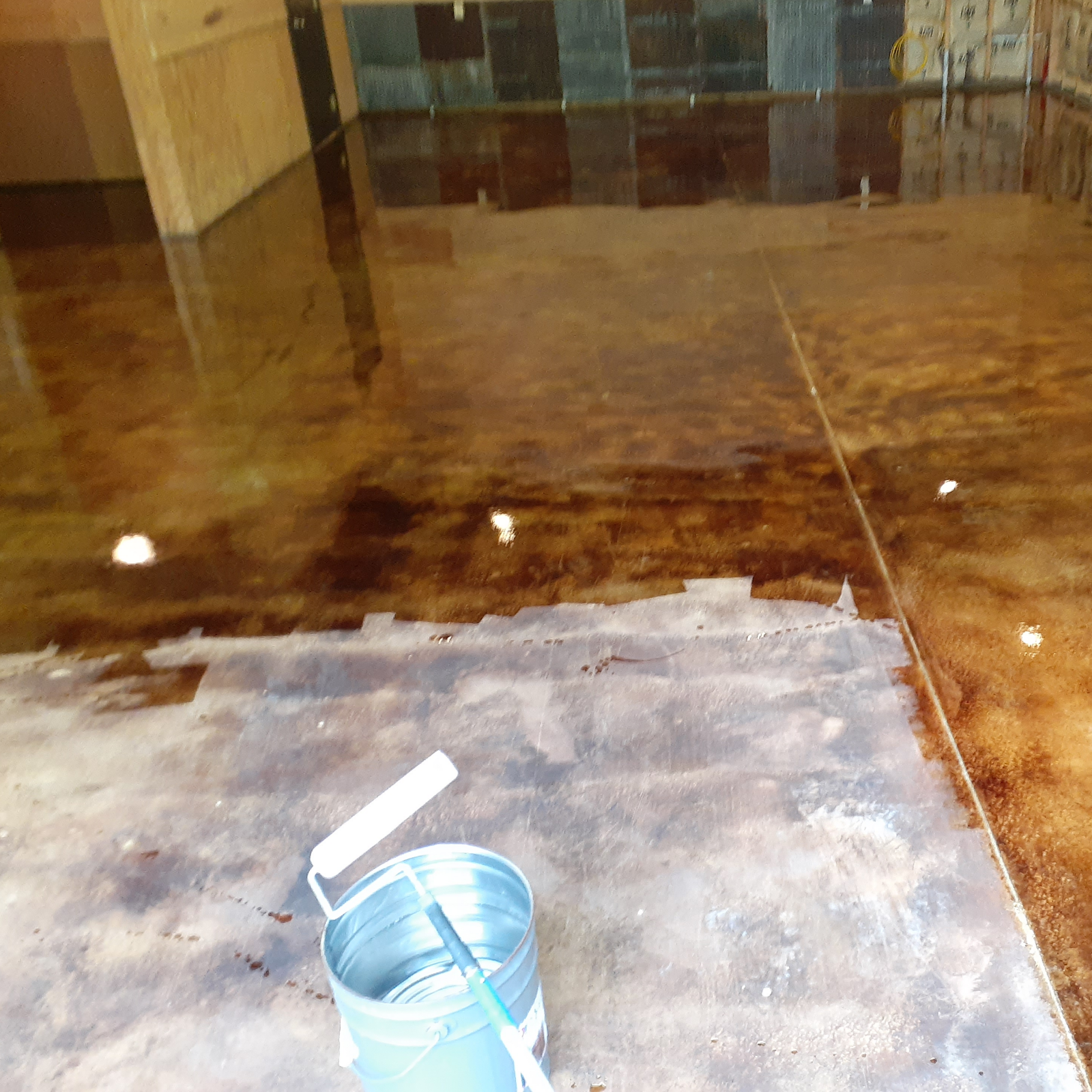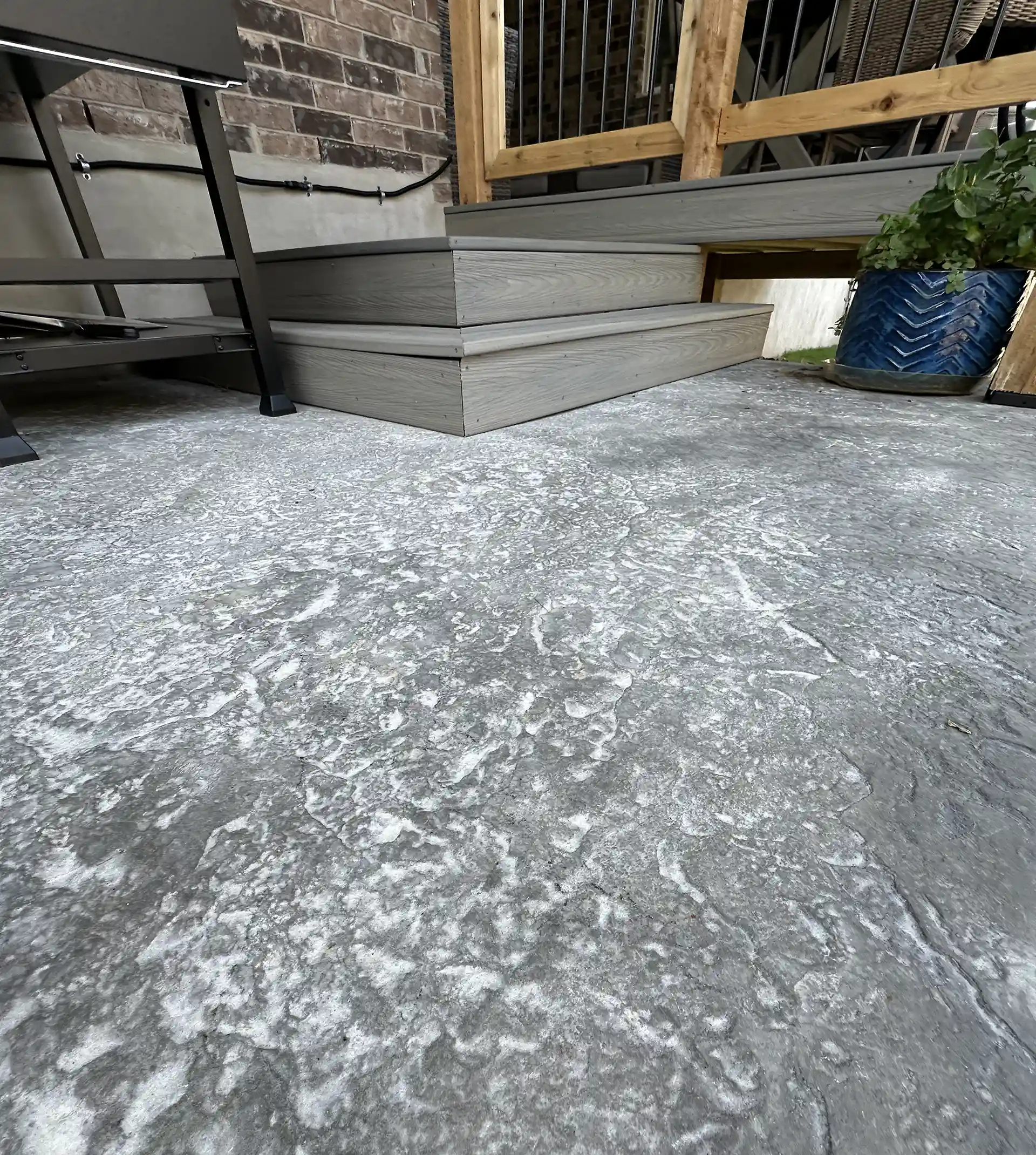Why stained concrete austin is the budget-friendly flooring solution
Everything About Stained Concrete: A Comprehensive Overview to Its Benefits and Applications
Stained concrete has actually emerged as a prominent option for both household and industrial rooms. Its capacity to integrate visual allure with usefulness makes it an intriguing choice. Different discoloration methods offer a range of colors and coatings, enabling modification. However, the advantages prolong past look. Comprehending its applications and maintenance requirements is vital for any person considering this flexible material. The nuances of stained concrete welcome better expedition.
What Is Stained Concrete?

Discoloration can be used to different surfaces, including floors, driveways, and patios, making it a flexible alternative for both interior and outdoor rooms. The therapy can achieve a series of looks, from earthy tones to strong, contemporary layouts. Unlike paint, stained concrete keeps its look over time, as it becomes an important part of the concrete itself. Generally, stained concrete functions as an effective method for changing common concrete into aesthetically striking surface areas.
Benefits of Stained Concrete
Stained concrete offers substantial advantages, particularly in aesthetic allure and sturdiness - Stained Concrete Floors Austin. Its vibrant shades and unique patterns improve the aesthetic appeal of any kind of area, making it a prominent option for both household and business applications. In addition, the durability of stained concrete guarantees that it remains a practical investment gradually, standing up to damage
Aesthetic Appeal
Among one of the most engaging benefits of utilizing stained concrete is its remarkable aesthetic allure. Stained concrete offers an one-of-a-kind and flexible look that can enhance numerous design styles, from modern-day to rustic. The infusion of vivid colors and intricate patterns enables house owners and designers to produce customized surface areas that can enhance the general setting of an area. Unlike traditional floor covering choices, stained concrete can imitate the look of all-natural stone or sleek marble, giving a high end appearance without the connected costs. In addition, the shiny coating choices can reflect light, additional brightening insides. This flexibility makes stained concrete a favored selection for both household and industrial applications, where aesthetic effect is paramount.
Toughness and Longevity
The remarkable aesthetic top qualities of stained concrete are enhanced by its impressive durability and longevity - Stained Concrete Austin. Stained concrete surfaces are resistant to put on and tear, making them ideal for high-traffic locations both inside and outdoors. Their durable nature means they can withstand rough weather, consisting of severe temperature levels, rainfall, and UV exposure, without significant destruction. On top of that, stained concrete calls for minimal maintenance contrasted to various other flooring choices, as it does not require frequent sealing or refinishing. This longevity not only decreases replacement prices however also contributes to a sustainable building method. On the whole, stained concrete gives a long-lasting remedy that incorporates aesthetic charm with sensible advantages, guaranteeing its value over time
Different Kinds Of Staining Methods
Various discoloration techniques can noticeably affect the aesthetic qualities of concrete surfaces. The three main approaches include acid discoloration, which reacts chemically with the concrete, water-based staining, which uses a more comprehensive series of shades, and overlay discoloration alternatives that provide a fresh surface. Each method has distinct features and applications that provide to different design choices and job demands.
Acid Staining Method
Just how can homeowners transform simple concrete surface areas into visually striking attributes? One reliable approach is acid discoloration, a popular strategy that improves the all-natural beauty of concrete. This process involves applying a solution of water, hydrochloric acid, and metallic salts to the concrete surface. As the acid responds with the lime existing in the concrete, it produces abundant, variegated colors that look like marble or stone. Acid staining is understood for its durability and resistance to fading, making it a durable choice for both indoor and exterior applications. However, it is vital to note that the results can differ based on the initial concrete shade and texture - Austin Stained Concrete Floors. Appropriate application and securing are important for accomplishing the wanted aesthetic and longevity
Water-Based Discoloration Strategy
A preferred option to acid discoloration, the water-based discoloration technique offers house owners a versatile way to enhance concrete surfaces. This technique uses water-soluble dyes and pigments, permitting for a variety of shades and coatings. Unlike acid stains, water-based spots can be applied to unsealed concrete and use a simpler cleaning process. The results can attain a much more uniform look and can be layered to develop unique impacts. Furthermore, water-based discolorations are generally less poisonous and send out fewer unstable natural substances (VOCs), making them extra ecologically friendly. Property owners might value the capacity to customize their concrete surfaces with various shades, permitting for creative expression while preserving resilience and long life in their flooring options.
Overlay Discoloration Options
Various overlay discoloration choices exist for property owners looking to rejuvenate their concrete surface areas. One preferred selection is straight from the source acid staining, which reacts chemically with the concrete to generate rich, variegated colors. Another alternative is water-based discoloration, providing a wider color palette and much easier application. In addition, concrete overlays can be integrated with patterns for detailed designs, improving visual appeals. For a more distinctive coating, homeowners may consider making use of stamped overlays that imitate natural materials like stone or tile. Each method provides one-of-a-kind advantages, from toughness to modification, enabling a customized touch. Inevitably, the option of overlay staining depends upon the wanted appearance and the condition of the existing concrete, making sure a refreshed and appealing surface area.
Applications of Stained Concrete
Stained concrete offers a flexible remedy for numerous applications, improving both aesthetic appeal and performance. This material is generally utilized in residential, commercial, and industrial settings, making it a popular choice amongst designers and designers. In homes, stained concrete can function as trendy flooring or outside patios, giving a sophisticated appearance while remaining sturdy.
In commercial spaces, such as retailers and restaurants, stained concrete adds to a modern-day atmosphere and can stand up to hefty foot traffic. In addition, stained concrete is increasingly made use of in public spaces like parks and walkways, where its capacity to resemble all-natural stone or other materials includes visual interest.
Stained concrete is optimal for swimming pool decks and driveways, offering a slip-resistant surface area that is easy to maintain. On the whole, the flexibility of stained concrete makes it suitable for various environments, satisfying diverse tastes and requirements.
Upkeep and Look After Stained Concrete
Correct maintenance ensures the durability and appeal of stained concrete surface areas. Normal cleaning is necessary; using a mild cleaning agent and water with a soft-bristle brush assists get rid of dust and grime without harming the coating. It is a good idea to prevent harsh chemicals that can remove the discolor or sealant.
Sealing stained concrete is essential for protection versus wetness, discolorations, and use. A high-quality sealer must be reapplied every one to 3 years, depending upon the traffic and exposure the surface sustains. Additionally, resolving spills without delay will protect against discoloration and discoloration.

Expense Factors To Consider for Stained Concrete Projects
When preparing a tarnished concrete task, budget plan factors to consider play a crucial role in establishing the total price. The expenditures related to stained concrete can differ considerably based upon a number of variables. The size of the area to be stained straight affects product and labor prices. Bigger rooms will naturally require more resources. Second, the kind of stain selected-- acid-based or water-based-- can influence prices, with acid discolorations commonly being extra expensive. Additionally, the intricacy of the style, including patterns or several shades, can increase labor expenses. Preparation work, such as cleaning and grinding the concrete surface area, contributes to the preliminary expenditures too. The option between DIY installation and employing a professional contractor will certainly better affect the spending plan. Recognizing these factors enables property owners to visit this site right here make informed monetary decisions regarding their stained concrete jobs, ensuring they attain the preferred visual within their economic means.
Tips for Choosing the Right Stained Concrete for Your Area
Picking the ideal stained concrete for a particular area involves careful reflection of different aspects beyond simply budget plan. One need to review the designated use of the area. High-traffic areas might require even more resilient finishes, while attractive applications can prioritize visual appeals.
The color palette is one more crucial facet; the selected colors need to integrate with existing decor and lighting. It's additionally crucial to take into consideration the surface texture, as smooth coatings can improve class, while distinctive options might guarantee safety in wet locations.
Regional climate and ecological conditions play a considerable role in the longevity and upkeep of stained concrete, affecting the option of sealants and finishes.
Lastly, speaking with professionals can offer beneficial understandings customized to specific needs, guaranteeing the selection of the optimal stained concrete why not check here that aligns with both capability and style.

Frequently Asked Inquiries
Can Stained Concrete Be Applied Over Existing Floor Covering?
Stained concrete can without a doubt be applied over existing floor covering, provided the surface area is secure and sufficiently prepared. This approach permits a visual upgrade without the need for full removal of the original flooring materials.
The Length Of Time Does Stained Concrete Last?
Stained concrete can last for years when effectively kept. Factors such as traffic, environmental problems, and application techniques significantly affect its durability, with many setups remaining lively and undamaged for 10 to three decades.
Is Stained Concrete Slippery When Damp?
Stained concrete can be slippery when damp, as the finish might create a smooth surface area. Using non-slip ingredients or distinctive finishes can mitigate this problem, enhancing safety and security without compromising the visual appeal of the concrete.
Can I Tarnish Concrete Myself, or Should I Work with a Professional?
The choice to tarnish concrete personally or work with a professional rest on ability level and job intricacy. While DIY discoloration can conserve money, experts guarantee ideal outcomes, specifically for complex designs or huge surfaces.
What Color styles Are Available for Stained Concrete?
The range of colors available for stained concrete consists of natural tones like browns and tans, lively tones such as reds and blues, and softer colors like pastels. This combination enables imaginative, personalized style options.